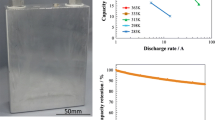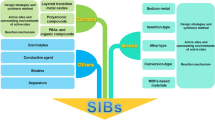Abstract
The heat generation connected to charging and discharging NaFePO4 (NFP) electrodes in sodium-ion batteries and LiFePO4 (LFP) electrodes in lithium-ion batteries is investigated. NFP-based electrodes are prepared with an electrochemical displacement method using LFP electrodes as the starting material. This approach guarantees identical particle size distribution, active material loading, binder, conductive additives, etc., of the electrodes. Consequently, differences in the heat generation rates are exclusively determined by the substitution of the alkali metal cation. Irreversible heat generation rates are computed from galvanostatic intermittent titration technique measurements at different C-rates. Reversible heat generation rates are determined by the temperature dependence of the equilibrium potential. For both, NFP and LFP electrodes, the total heat generation increases with increasing C-rate. The reversible heat is found to be significant at low C-rate, whereas the irreversible heat dominates at high C-rate. For both NFP and LFP electrodes, differences in the total heat generation rates during charging and discharging are mainly attributed to the reversible heat. The comparison between NFP and LFP reveals substantially larger heat generation rates for NFP electrodes, which are mainly caused by larger limitations of charge transfer reaction and the solid-state diffusion.

ᅟ








Similar content being viewed by others
Abbreviations
- a:
-
Power law constant [−]
- C:
-
Capacity [As]
- C-rate:
-
Relative charge-discharge rate ([“C”] [h−1])
- E :
-
Electrode potential [V]
- F :
-
Faraday constant (96,485.3 [A s mol−1])
- I :
-
Electric current [A]
- q :
-
Volumetric heat generation rate [W L−1]
- Q :
-
Dissipated heat [kJ L−1]
- R :
-
Electrical resistance [Ω]
- S :
-
Entropy [J mol−1 K−1]
- t :
-
Time [s]
- T :
-
Temperature [K]
- V :
-
Volume [L]
- x :
-
Stoichiometric factor [−]
- z :
-
Valence [−]
- ∂:
-
Differential operator [−]
- Δ :
-
Difference [−]
- η :
-
Overpotential [V]
- τ :
-
Charge-discharge time [s]
- irr:
-
Refers to irreversible heat
- rev:
-
Refers to reversible heat
- tot:
-
Refers to total heat
- eq:
-
Refers to equilibrium conditions
- n:
-
Indexing different heat effects
- Ω:
-
Refers to ohmic resistance
References
Maleki H, Deng G, Anani A et al (1999) Thermal stability studies of Li-ion cells and components. J Electrochem Soc 146(9):3224–3229
Spotnitz R, Franklin J (2003) Abuse behavior of high-power, lithium-ion cells. J Power Sources 113(1):81–100
Wang Q, Ping P, Zhao X et al (2012) Thermal runaway caused fire and explosion of lithium ion battery. J Power Sources 208:210–224
Al Hallaj S, Maleki H, Hong JS et al (1999) Thermal modeling and design considerations of lithium-ion batteries. J Power Sources 83(1–2):1–8
Zhang X, Sastry AM, Shyy W (2008) Intercalation-induced stress and heat generation within single lithium-ion battery cathode particles. J Electrochem Soc 155(7):A542–A552
Bandhauer TM, Garimella S, Fuller TF (2014) Temperature-dependent electrochemical heat generation in a commercial lithium-ion battery. J Power Sources 247:618–628
Ye Y, Shi Y, Cai N et al (2012) Electro-thermal modeling and experimental validation for lithium ion battery. J Power Sources 199:227–238
Heubner C, Schneider M, Michaelis A (2016) Detailed study of heat generation in porous LiCoO2 electrodes. J Power Sources 307:199–207
Kim S, Seo D, Ma X et al (2012) Electrode materials for rechargeable sodium-ion batteries: potential alternatives to current lithium-ion batteries. Adv Energy Mater 2(7):710–721
Palomares V, Serras P, Villaluenga I et al (2012) Na-ion batteries, recent advances and present challenges to become low cost energy storage systems. Energy Environ Sci 5(3):5884–5901
Pan H, Y-S H, Chen L (2013) Room-temperature stationary sodium-ion batteries for large-scale electric energy storage. Energy Environ Sci 6(8):2338–2360
Yabuuchi N, Kubota K, Dahbi M et al (2014) Research development on sodium-ion batteries. Chem Rev 114(23):11636–11611
Hong SY, Kim Y, Park Y et al (2013) Charge carriers in rechargeable batteries: Na ions vs. Li ions. Energy Environ Sci 6(7):2067–2081
Thomas KE, Newman J (2003) Heats of mixing and of entropy in porous insertion electrodes. J Power Sources 119–121:844–849
Bernardi D, Pawlikowski E, Newman J (1985) A general energy balance for battery systems. J Electrochem Soc 132(1):5–12
Gu WB, Wang CY (2000) Thermal-electrochemical modeling of battery systems. J Electrochem Soc 147(8):2910
Meethong N, Huang H-YS, Carter WC et al (2007) Size-dependent lithium miscibility gap in nanoscale Li1−xFePO4. Electrochem Solid-State Lett 10(5):A134–A138
Gibot P, Casas-Cabanas M, Laffont L et al (2008) Room-temperature single-phase Li insertion/extraction in nanoscale LixFePO4. Nat Mater 7(9):741–747
Malik R, Burch D, Bazant M et al (2010) Particle size dependence of the ionic diffusivity. Nano Lett 10(10):4123–4127
Zheng H, Li J, Song X et al (2012) A comprehensive understanding of electrode thickness effects on the electrochemical performances of Li-ion battery cathodes. Electrochim Acta 71:258–265
Wiedemann AH, Goldin GM, Barnett SA et al (2013) Effects of three-dimensional cathode microstructure on the performance of lithium-ion battery cathodes. Electrochim Acta 88:580–588
Oh S, Lee JK, Byun D et al (2004) Effect of Al2O3 coating on electrochemical performance of LiCoO2 as cathode materials for secondary lithium batteries. J Power Sources 132(1–2):249–255
Shin HC, Cho WI, Jang H (2006) Electrochemical properties of carbon-coated LiFePO4 cathode using graphite, carbon black, and acetylene black. Electrochim Acta 52(4):1472–1476
Heubner C, Heiden S, Matthey B et al. (2016) Sodiation vs. Lithiation of FePO4: A comparative kinetic study. Electrochim Acta 216:412-419
Hong J, Maleki H, Al Hallaj S et al (1998) Electrochemical-calorimetric studies of lithium-ion cells. J Electrochem Soc 145(5):1489–1501
Viswanathan VV, Choi D, Wang D et al (2010) Effect of entropy change of lithium intercalation in cathodes and anodes on Li-ion battery thermal management. J Power Sources 195(11):3720–3729
Reynier Y, Yazami R, Fultz B (2003) The entropy and enthalpy of lithium intercalation into graphite. J Power Sources 119–121:850–855
Takano K, Saito Y, Kanari K et al (2002) Entropy change in lithium ion cells on charge and discharge. J Appl Electrochem 32(3):251–258
Moreau P, Guyomard D, Gaubicher J et al (2010) Structure and stability of sodium intercalated phases in olivine FePO4. Chem Mater 22(14):4126–4128
Galceran M, Saurel D, Acebedo B et al (2014) The mechanism of NaFePO4 (de)sodiation determined by in situ X-ray diffraction. Phys Chem Chem Phys 16(19):8837–8842
Gaubicher J, Boucher F, Moreau P et al (2014) Abnormal operando structural behavior of sodium battery material: influence of dynamic on phase diagram of NaxFePO4. Electrochem Commun 38:104–106
Heubner C, Heiden S, Schneider M et al (2017) In-situ preparation and electrochemical characterization of submicron sized NaFePO4 cathode material for sodium-ion batteries. Electrochim Acta 233:78–84
Weppner W, Huggins RA (1977) Determination of the kinetic parameters of mixed-conducting electrodes and application to the system Li3Sb. J Electrochem Soc 124(10):1569–1578
Zhu Y, Xu Y, Liu Y et al (2013) Comparison of electrochemical performances of olivine NaFePO4 in sodium-ion batteries and olivine LiFePO4 in lithium-ion batteries. Nanoscale 5(2):780
Joachin H, Kaun TD, Zaghib K et al (2009) Electrochemical and thermal studies of carbon-coated LiFePO4 cathode. J Electrochem Soc 156(6):A401
Dixit M, Engel H, Eitan R et al (2015) Classical and quantum modeling of Li and Na diffusion in FePO4. J Phys Chem C 119(28):15801–15815
Slater MD, Kim D, Lee E et al (2013) Sodium-ion batteries. Adv Funct Mater 23(8):947–958
Author information
Authors and Affiliations
Corresponding author
Rights and permissions
About this article
Cite this article
Heubner, C., Schneider, M. & Michaelis, A. Heat generation rates of NaFePO4 electrodes for sodium-ion batteries and LiFePO4 electrodes for lithium-ion batteries: a comparative study. J Solid State Electrochem 22, 1099–1108 (2018). https://doi.org/10.1007/s10008-017-3828-4
Received:
Revised:
Accepted:
Published:
Issue Date:
DOI: https://doi.org/10.1007/s10008-017-3828-4




